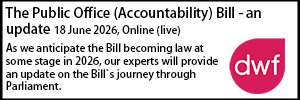Disclosure in procurement disputes
- Details
A recent judgment has significant implications for public procurement and the disclosure of documents in English law, writes Cheye Waithe.
On 14 December 2023 HHJ Pearce KC (sitting as a judge of the High Court) handed down his judgment in the case of OCS Group UK Limited v Community Health Partnerships Limited. The case concerned a public procurement dispute in which the claimant, OCS, made an application for the disclosure of specific documents.
OCS Group UK Limited (OCS) is a facilities management company that provides services including cleaning services to a range of clients, including Community Health Partnerships Limited (CHP), a public sector body responsible for managing healthcare facilities. The claimant is the incumbent provider of such services to the defendant. The new contract, in respect of which this claim is brought, has a value of roughly £236 million and a term of around nine years making it a very significant contract.
During the call-off competition there was a detailed evaluation of price and quality related award criteria and there was only a difference in aggregate scores between the claimant and the winning bidder of 0.02%. Such a slight difference could mean that if there was an error in one mark in any of the scores awarded then it would change the overall result.
The dispute between the parties arose when the defendant, CHP, in its award letter failed to provide reasoning for why each of the winning bidder’s scores did not achieve the maximum score. This was not comparable to the reasoning for the claimant’s scores. The claimant immediately raised concerns with the defendant over their procurement process and then sought a disclosure of specific material that was not given. A claim was then issued.
The claimant’s proceedings revolve around three principal heads of complaint: firstly, that the claimant’s score for a particular question was unlawful/too low based on the defendant’s stated reasons, which indicated it had misconstrued the applicable award and scoring criteria; secondly, the claimant’s score for a different question was also unlawful/too low based on the defendant’s stated reasons, which were manifestly wrong on their face having regard to the content of the claimant’s tender response; critically, the defendant was in breach of the reg. 18, PCR 2015 duty of transparency due to the failure to provide any transparent/sufficient statement of reasons in respect of the winning bidder’s quality related scores.
The defendant contended that firstly its award letter complied with the requirements of reg. 86, PCR 2015 because it provided a summary of the characteristics and relevant advantages of the preferred bid, i.e., the defendant argued there was no requirement to disclose the reasons for individual scores; and secondly that it had complied with any requirement imposed by the duty of transparency under reg. 18, PCR 2015.
HHJ Pearce KC applying Lancashire Care NHS Foundation Trust v Lancashire County Council [2018] EWHC 1589 (TCC) per Stuart-Smith J, found that the duty of transparency required the contracting authority to demonstrate sufficient reasons for the scores awarded (paragraph 68). This duty applies at the date of the contract award decision (paragraph 69).
The fact that the claimant had established clearly arguable complaints on its own scores of Q13 and 6 was capable of supporting the view that if reasons were disclosed for the winning bidder’s scores for the quality related questions this may give rise to grounds of potential prima facie challenge to seek disclosure on other issues (paragraph 72).
However, at paragraph 73, the Judge stated the central question ‘is whether the material before the court amounts to the adequate giving of reasons in respect’ of the winning bidder’s score. In his judgment, it did not do so. The Judge highlighted ‘that there is an essential step in the reasoning for the score on the Mitie bid that is missing, namely, at least some indication as to what it could have done to receive a higher score or putting the same point the other way around, why it did not receive full marks on that’ (paragraph 74).
Notably, the Judge was of the view that it was only the combination of the arguable grounds of complaint in respect of Q13 and 6 together with the inadequacy of reasons for the winning bidder’s quality related scores which meant that the test for Roche disclosure was satisfied (paragraph 75).
The defendant sought permission on the basis that the further guidance at the Court of Appeal was required on the application of the Roche principles in procurement disputes. The three principal proposed grounds were; the Judge erred in applying too low a threshold in respect of ‘prima facie’ case; the Judge erred in holding that the existence of seriously arguable issues in respect of Q13 and 6 could support the existence of a prima facie case in respect of the transparency complaint concerning the reasons for the winning bidder’s scores; the Judge erred in holding that the reasons provided in respect of the winning bidder’s scores were inadequate.
Coulson LJ (author of the Roche principles) dismissed the appeal. Most importantly, he held that the Judge at first instance had been too restrictive in suggesting that the inadequacy of reasons for the winning bidder’s scores alone would be insufficient to order disclosure, without support from other seriously arguable breaches.
The threshold for prima facie public procurement dispute cases is modest. This means that seriously arguable errors in one part of the evaluation are likely to be regarded as capable of supporting an application for disclosure relating to other, different, elements of the evaluation. This goes further than previously thought. Furthermore, if the reasons provided for a particular element of an evaluation are inadequate then this may lead to a successful Roche application (per Coulson LJ).
The key takeaways are that in the context of the procurement where the process has used conventional evaluation structure, then following OCS, it is likely that if inadequate reasons are provided, a Roche application will succeed. Where there are seriously arguable errors in one part of the evaluation, this is likely to support an application for disclosure relating to other, different, elements of the evaluation. This is a significant judgment as it clarifies that the threshold for prima facie cases is modest meaning seriously arguable errors in one part of the evaluation are likely to be regarded as capable of supporting an application for disclosure relating to other, different, elements of the evaluation. It also clarifies the likelihood of where the Roche principles will apply. One point to raise is that had the defendant not provided any reasons for any of the scores awarded then the claimant would not have been able to formulate any serious arguable grounds of complaint, in which case it is unlikely that they could seek disclosure using Roche. Therefore, if you are going to provide reasoning, it is essential to ensure that it is adequate and complies with Regulation 18 of PCR 2015.
Cheye Waithe is a Trainee Solicitor at Browne Jacobson.
Sponsored articles
Walker Morris supports Tower Hamlets Council in first known Remediation Contribution Order application issued by local authority
Unlocking legal talent
Lawyer (Planning and Regulatory)
Contracts Lawyer
Legal Director - Government and Public Sector
Principal Lawyer - Planning, Property & Contract
Senior Lawyer - Planning, Property & Contracts Team
Locums
Poll
15-07-2026 11:00 am


















































